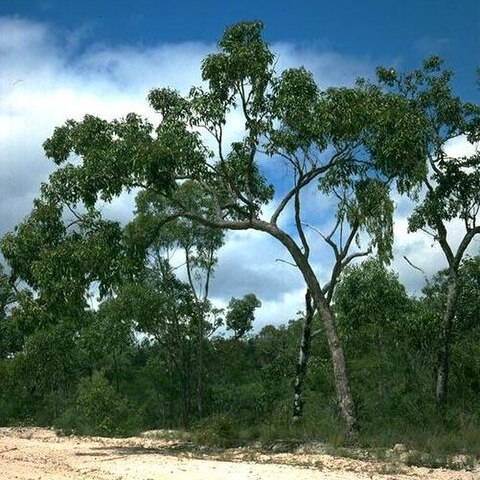Tree 3 m to 12 m tall. Forming a lignotuber.Bark rough, more or less tessellated or at least deeply fissured, coarsely fibrous and brittle, extending over trunk and limbs to 5–10 cm diameter, greyish brown.Branchlets smooth (glabrous); long oil ducts sometimes visible in the pith.Juvenile growth (coppice or field seedlings to 50 cm): stems rounded in cross-section, setose; juvenile leaves always shortly petiolate, opposite for ca 20 nodes then becoming alternate, ovate-elliptic to elliptic-lanceolate, (4.5)8–13.5 cm long, (1.3)2–5(8) cm wide, base rounded or tapering to petiole, apex rounded or scarcely pointed, green, discolorous, glossy above, glabrous except for setae on petiole.Adult leaves predominantly alternate but opposite and sub-opposite pairs are always present, petioles 1.3–4 cm long; blade lanceolate to broadly so, ovate intermediate leaves present at times, 8–15.2(18) cm long, 2–6.4 cm wide, base rounded or tapering to petiole, margin entire, apex finely pointed, strongly discolorous, glossy dark green above, paler below, smooth, side-veins at greater than 45° to midrib, reticulation dense to very dense, intramarginal vein present but very close to margin (more easily seen from underside when dry), oil glands small, island.Inflorescence terminal compound, peduncles rounded, 0.5–3.8 cm long, buds in umbels of (3)7, usually sessile, very rarely with pedicels to 0.5 cm long and then most other buds in that umbel sessile. Mature buds ovoid to obovoid to broadly fusiform (1.2–1.8 cm long, 0.8–1.1 cm wide), basally green with operculum rusty and ± scurfy to warty, scar absent (both opercula shed together at flowering), operculum rounded to conical and with the thick outer (calycine) operculum incompletely fused at the apex of lobes whilst inner (petaline) operculum is much thinner and completely fused but with 4 suture lines visible on its surface, stamens inflexed, all fertile, anthers oblong, dorsifixed, versatile, dehiscing by longitudinal slits, style long and straight, stigma blunt and shortly papillose, locules 4, the ovules not arranged in clear rows on the placentae (sometimes 7 rows ± discernable). Flowers creamy white.Fruit sessile, truncate-ovoid to barrel-shaped lacking a contracted neck but having a very thick rim, rarely slightly urceolate, (1.8)2.1–3.4 cm long, (1.5)1.8–2.6 cm wide, longer than wide, ± rusty, rim thick, flat and sometimes split but disc descending vertically from the rim, valves 4, enclosed.Seeds brown to red-brown, 6–12(14) mm long, ellipsoidal with terminal wing, hilum ventral.Cultivated seedlings (measured at ca node 10): cotyledons reniform; stems rounded in cross-section, setose with long bristle-glands; leaves petiolate, opposite, ovate-elliptic, 7–10.5 cm long, 1.7–5.5 cm wide, base rounded at lower nodes but from ca node 6–8 to node 14 peltate, apex rounded or bluntly pointed, green, discolorous, glossy above after node ca 7, sparsely setose on both sides especially on midrib and margins throughout seedling phase.
More
Tree to 14 m. Bark irregularly tessellated or subfibrous throughout, grey-brown. Juvenile leaves subopposite, petiolate, ovate. Adult leaves alternate, petiolate, broadly lanceolate, acuminate, rounded at base, thick; lamina 10–12 cm long, 2.5–5 cm wide, green, strongly discolorous; lateral veins many, at 70°–80°; intramarginal vein very close to or confluent with margin; petiole channelled, 20–30 mm long. Umbels 3–7-flowered; peduncle flattened towards end, 20–30 mm long; pedicels absent. Buds ovoid; operculum conical, 5–7 mm long, 7–12 mm wide; hypanthium hemispherical or truncate-ovoid, faintly striate, 10–12 mm long, 7–12 mm wide. Fruits ovoid to subglobular, 20–30 mm long, 15–25 mm wide. Seeds with terminal wing, yellow-brown.


